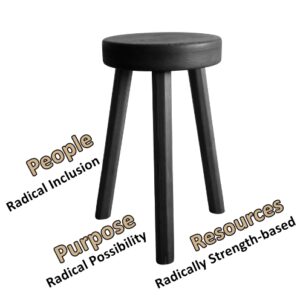These are scary times for leaders of community benefit groups and organizations. We watch as an authoritarian government strips our communities of the things that make them livable, disappearing people from their communities without due process, and eliminating safety nets.
And we wait for them to come after our organizations themselves, either by repealing funding, threatening to eliminate our tax exemption, or simply keeping us afraid of possible repurcussions if we go against their cruel and inhumane interests.
In times like these, it is easy to feel powerless. Helpless. Alone.
And while Catalytic Thinking isn’t a magic wand, the questions in that framework CAN provide ways to step into our power at a time when we’re feeling powerless.
 We talk about Catalytic Thinking as addressing the 3 legs of the stool that supports the work of social change groups: People, purpose, and resources. We talk about those 3 legs as Radical Inclusion (people), Radical Possibility (purpose), and Radical Strength (resources). You can read an overview of the framework at this link.
We talk about Catalytic Thinking as addressing the 3 legs of the stool that supports the work of social change groups: People, purpose, and resources. We talk about those 3 legs as Radical Inclusion (people), Radical Possibility (purpose), and Radical Strength (resources). You can read an overview of the framework at this link.
In this brief article, let’s review those 3 pillars, to remind you of the power you already have.
Radical Inclusion
When it comes to stepping into our power, that power is the power of all of us together. This is not about your community joining you in your work; it’s about you joining your community. That is the power of ALL of us.
Radical inclusion is the notion that the people who will be affected by a decision or plan are the ones who will (at best) make those decisions, and (at least) be part of those decisions. That is the spirit of what began as the rallying cry of the disability rights movement: Nothing about us without us.
Some of the questions of Radical Inclusion are…
- Who will be affected by whatever we are thinking about?
- What would it take for them to be part of the decision / to lead the direction we take?
The power of Radical Inclusion is the power of igniting your whole community in support of their needs and aspirations. When we are fighting together as part of our community, we are building strength in our community while fighting to keep our communities healthy and safe.
Radical Possibility
It can take effort to think about possibility when times are hard. That’s why we let the questions of Catalytic Thinking do that heavy lifting for us. Once we’ve determined that we will work together with our communities, those questions are all about what our communities aspire to. This is about creating what is possible vs. solely reacting to what isn’t working.
This is important all the time, but especially now. Because if all we do is resist and react, without also creating the future we want to step into, we are damning ourselves to always be playing defense.
Some of the questions of Radical Possibility are…
- What is the high potential outcome we want from our work?
- What conditions will lead to those outcomes? What needs to be in place for those outcomes to be reality?
Radical Strength
If there is one thing every social change and community benefit group worries about, it is resources. Even on a good day, we feel like there is never enough. And these days are definitely not the good days! Everywhere in the world, groups who are funded by U.S. based government and foundation funding are worried about what will happen to their grants. And donors who are affected by their investments worry that the global economy is unstable, leading to worries about whether those donors can afford to provide support.
Radical Strength is about building on the assets we already have. People assets, stuff assets (vehicles, office space), mission assets. Even more than that, it is about building on the assets of our communities – the people, stuff, and mission assets of everyone else in town. Instead of the zero-based funding we are all accustomed to, Radical Strength asks first about what we already have to build upon.
Those questions include…
- What do we really need? Not money – the things the money would buy us?
- What do we already have to build upon?
- Who else in our community has what we need, and what would it take to partner with them for those resources?
Radical Strength is the opposite of feeling dependent and weak. Radical Strength turns the efforts of one organization into the efforts of an entire community. That’s why it is radical!
By focusing on the three pillars that support the work of social change groups, Catalytic Thinking helps groups see the power they already have, and step into that power. In these uncertain times, that focus is needed more than ever.
Because our power is each other. And these questions can help guide the way for all of us to build what is possible, together.
Want to dive deeper into what it takes to step into our power in these times? Join our webinar October 22nd. Info is here.

